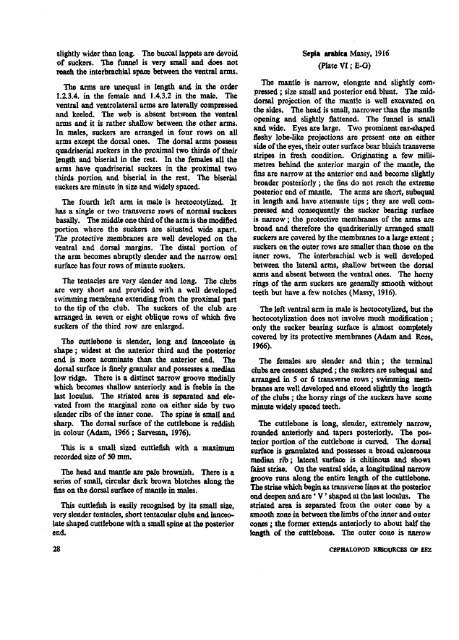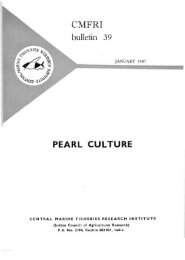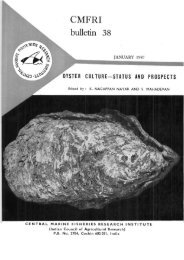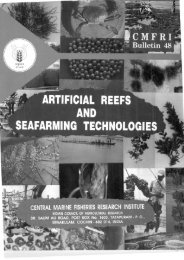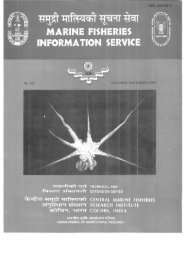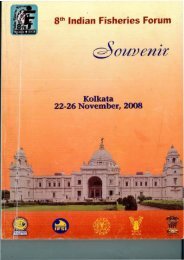bulletin 37 - Eprints@CMFRI - Central Marine Fisheries Research ...
bulletin 37 - Eprints@CMFRI - Central Marine Fisheries Research ...
bulletin 37 - Eprints@CMFRI - Central Marine Fisheries Research ...
Create successful ePaper yourself
Turn your PDF publications into a flip-book with our unique Google optimized e-Paper software.
slightly wider than long. The buccal lappets are devoidof suckers. The funnel is very small and does notreach the interbrachial space between the ventral arms.The arms are unequal in length and in the order1.2.3.4. in the female and 1.4.3.2 in the male. Theventral and ventrolateral arms are laterally compressedand keeled. The web is absent between the ventralarms and it is rather shallow between the other arms.In males, suckers are arranged in four rows on allarms except the dorsal ones. The dorsal arms possessquadriserial suckers in the proximal two thirds of theirlength and biserial in the rest. In the females all thearms have quadriserial suckers in the proximal twothirds portion and biserial in the rest. The biserialsuckers are minute in size and widely spaced.The fourth left arm in male is hectocotylized. Ithas a single or two transverse rows of normal suckersbasally. The middle one third of the arm is the modifiedportion where the suckers are situated wide apart.The protective menibranes are well developed on theventral and dorsal margins. The distal portion ofthe arm becomes abruptly slender and the narrow oralsurface has four rows of minute suckers.The tentacles are very slender and long. The clubsare very short and provided with a well developedswimming membrane extending from the proximal partto the tip of the club. The suckers of the club arearranged in seven or eight oblique rows of which fivesuckers of the third row are enlarged.The cuttlebone is slender, long and lanceolate inshape; widest at the anterior third and the posteriorend is more acuminate than the anterior end. Thedorsal surface is finely granular and possesses a medianlow ridge. There is a distinct narrow groove mediallywhich becomes shallow anteriorly and is feeble in thelast loculus. The striated area is separated and elevatedfrom the marginal zone on either side by twoslender ribs of the inner cone. The spine is small andsharp. The dorsal surface of the cuttlebone is reddishin colour (Adam, 1966 ; Sarvesan, 1976).This is a small sized cuttlefish with a maximumrecorded size of 50 mm.The head and mantle are pale brownish. There is aseries of small, circular dark brown blotches along thefins on the dorsal surface of mantle in males.This cuttlefish is easily recognised by its small size,very slender tentacles, short tentacular clubs and lanceolateshaped cuttlebone with a small spine at the posteriorend.Sepia arabica Massy, 1916(Plate VI; E-G)The mantle is narrow, elongate and slightly compressed; size small and posterior end blunt. The middorsalprojection of the mantle is well excavated onthe sides. The head is small, narrower than the mantleopening and slightly flattened. The funnel is smalland wide. Eyes are large. Two prominent ear-shapedfleshy lobe-like projections are present one on eitherside of the eyes, their outer surface bear bluish transversestripes in fresh condition. Originating a few millimetresbehind the anterior margin of the mantle, thefins are narrow at the anterior end and become slightlybroader posteriorly ; the fins do not reach the extremeposterior end of mantle. The arms are short, subequalin length and have attenuate tips; they are well compressedand consequently the sucker bearing surfaceis narrow; the protective membranes of the arms arebroad and therefore the quadriserially arranged smallsuckers are covered by the membranes to a large extent;suckers on the outer rows are smaller than those on theinner rows. The interbrachial web is well developedbetween the lateral arms, shallow between the dorsalarms and absent between the ventral ones. The hornyrings of the arm suckers are generally smooth withoutteeth but have a few notches (Massy, 1916).The left ventral arm in male is hectocotylized, but thehectocotylization does not involve much modification ;only the sucker bearing surface is almost completelycovered by its protective membranes (Adam and Rees,1966).The females are slender and thin; the terminalclubs are crescent shaped; the suckers are subequ^ andarranged in 5 or 6 transverse rows ; swimming membranesare well developed and exceed slightly the lengthof the clubs ; the homy rings of the suckers have someminute widely spaced teeth.The cuttlebone is long, slender, extremely narrow,rounded anteriorly and tapers posteriorly. The posteriorportion of the cuttlebone is curved. The dorsalsurface is granulated and possesses a broad calcareousmedian rib; lateral surface is chitinous and showsfaint striae. On the ventral side, a longitudinal narrowgroove runs along the entire length of the cuttlebone.The striae which begin as transverse lines at the posteriorend deepen and are' V' sljaped at the last loculus. Thestriated area is separated from the outer cone by asmooth zone in between the limbs of the inner and outercones ; the former extends anteriorly to about half thelength of the cuttlebone. The outer cone is narrow28 CEPHALOPOD RESOURCES OF EEZ


